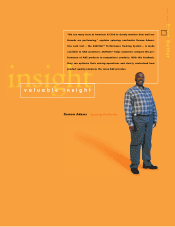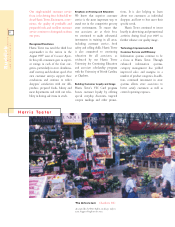Harris Teeter 1997 Annual Report Download - page 18
Download and view the complete annual report
Please find page 18 of the 1997 Harris Teeter annual report below. You can navigate through the pages in the report by either clicking on the pages listed below, or by using the keyword search tool below to find specific information within the annual report.
Ruddick
RUDDICK CORPORATION
AND SUBSIDIARIES
16
receivable related to the expansion of A&E’s domestic and
international sales and due to higher pre-paid assets at
Harris Teeter. The current ratio was 1.4at September 28,
1997 and 1.3at September 29, 1996.
Covenants in certain of the Company’s long-term
debt agreements limit the total indebtedness that the
Company may incur. The Company remains well within
such covenants. Management believes that the limit on
indebtedness does not significantly restrict the Company’s
liquidity and that such liquidity is adequate to meet fore-
seeable requirements.
In fiscal 1997, capital expenditures were $115.3million. In
fiscal 1998, capital expenditures are expected to be not more
than $132 million. In order to complete the integration of
Threads USA and for further modernization and expan-
sion, American & Efird expects to spend $39 million. In the
very competitive southeastern U.S. grocery market, Harris
Teeter has capital expenditure plans totaling $93 million.
The Harris Teeter estimates include the fiscal 1998 opening
of 12 new stores, one of which is a replacement, and three
additional stores are expected to be closed. New store loca-
tions include three in Virginia, two in Atlanta, Georgia, one
in Nashville, Tennessee, five in North Carolina and one in
Jacksonville, Florida, a new market for Harris Teeter and its
sixth state. The expansion that began in 1997 of Harris
Teeter’s two distribution centers is expected to be complet-
ed in 1998. The total cost of the project is still estimated at
$40 to $45 million and Harris Teeter anticipates spending
approximately $25 million in fiscal 1998. Management
expects that internally generated funds, supplemented by
available borrowing capacity, will be adequate to finance
such expenditures.
Other Matters
The Company has several initiatives underway for the
improvement of information systems, including the modi-
fication or conversion of Company computer systems to
provide for proper functioning beyond calendar year 1999.
It is anticipated that substantially all of these Year 2000
costs will be incurred during fiscal 1998 and 1999. The
Company expects to complete its Year 2000 cost estimates
by mid-1998. Maintenance or modification costs will be
expensed as incurred, while the costs of new software will
be capitalized and amortized over the software’s useful life.
Management believes that resources are available to com-
plete the modification and conversion and that its costs will
not materially effect the Company’s operating results or
financial condition. Management believes that the Year 2000
compliance will be completed well before the end of fiscal
year 1999. It must be recognized, however, that failure to do
so could have a material adverse effect on the Company’s
future results of operations.
During fiscal year 1996, the Company announced to its
shareholders the adoption of a Dividend Reinvestment and
Stock Purchase Plan available to all shareholders of record.
The foregoing discussion contains some forward-
looking statements about the Company’s financial
condition and results of operations, which are subject to
certain risks and uncertainties that could cause actual
results to differ materially from those reflected in the
forward-looking statements. Readers are cautioned not to
place undue reliance on these forward-looking statements,
which reflect management’s judgment only as of the date
hereof. The Company undertakes no obligation to publicly
revise these forward-looking statements to reflect events
and circumstances that arise after the date hereof.
Factors that might cause the Company’s actual results
to differ materially from those anticipated in forward-look-
ing statements include the following:
• generally adverse economic and industry conditions,
including a decline in consumer demand for apparel products
or significant changes in consumer food preferences or
eating habits,
• changes in the competitive environment, including
increased competition in the Company’s primary geograph-
ic markets, the entry of new competitors and consolidation
in the supermarket industry,
• economic or political changes in the countries in which
the Company operates or adverse trade regulations,
• the passage of future tax legislation, if any, that could
have an adverse impact on the tax benefits of the ESOP
dividends and COLI,
• management’s ability to accurately predict the adequacy of
the Company’s present liquidity to meet future requirements,
• changes in the Company’s capital expenditures, new store
openings and store closings, and
• non-availability of resources for the Company, or its
suppliers and customers, to complete their respective Year
2000 compliance effectively.
























